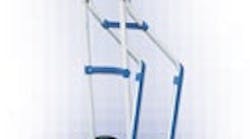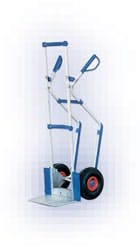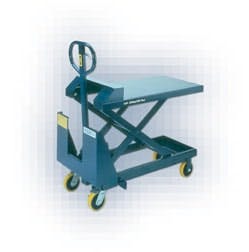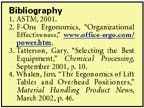Although major changes in ergonomic legislation are not expected soon, the process industries must not lose sight of ergonomics-related safety issues. It pays to review and assess safety benefits and to continue to make progress with improved designs.
In April of this year, John L. Henshaw, assistant secretary of Labor for Occupational Safety and Health, announced details about the formation of the National Advisory Committee on Ergonomics. This committee is part of the Occupational Safety and Health Administration's (OSHA) comprehensive approach to reducing ergonomic-related injuries and illnesses in the workplace.
The committee will provide advice on a number of issues involving information about various industry or task-specific guidelines; identification of gaps in the existing research on ergonomics and the application of ergonomic principles to the workplace; and current and projected research needs and efforts. Other issues to be covered include methods of providing outreach and assistance that will communicate the value of ergonomics to employers and employees, as well as ways to increase communication among stakeholders on the issue of ergonomics.
In mid-2001, the American Society for Testing and Materials (ASTM) Committee E34 on Occupational Health and Safety drafted voluntary consensus guidelines on the scientific discipline of ergonomics. These guidelines now are being reviewed by more than 70 ergonomics professionals, including representatives of industry, universities, consulting firms and equipment suppliers.
Dennis R. Ankrum, director of Human Factors Research, Nova Solutions Inc., Effingham, Ill., said typical users of the proposed guide will be engineers, industrial designers and other planners of occupational space. "The repealed [,] standard was not an ergonomic standard," he explains. "It was a standard to reduce work-related muscular-skeletal injuries. Ergonomics is much broader than injuries. Good ergonomics design means matching jobs to the capabilities and limitations of the workers. While fewer injuries would be expected, the real benefit to business is an increase in productivity."
Angled handles and an extra-high back combine to maneuver loads as large as 500 pounds (lb).
Factors affecting selection
Although industrial, chemical and petrochemical plants want to use only the best equipment and machines for their operations and processes, these assets must be selected based on safety, size, capacity, power requirements and cost. In recent years, the practice of ergonomics has become a necessity because ergonomic design often means improved safety.
Equipment selection usually is quite involved; many factors must be considered. When engineers and designers select equipment, human considerations (see sidebar), technology and common company practices must not be overlooked.
|
An Ergonomic Checklist for Equipment Designers 1.What is the operator expected to do? Will optimum use be made of his or her capacities? Should functions that the operator cannot do very well be transferred to the equipment? 2. Will the equipment fit the operator? Is it planned with the operator in mind? 3. Will the operator sit or stand? Will the operator's posture introduce stress? 4. Will males, females or both operate the equipment? Is the equipment designed accordingly? 5. What information does the operator need to do the job? Will the information available to the operator be visual, auditory or tactual? What part will instruments play in efficient equipment operation? 6. What controls will be provided and what type will they be? Will a foot control be necessary? Does the operator need to exert much force? 7. What physical work will be required of the operator? Will some type of mechanical assistance be provided? 8. What will be the ambient conditions at the equipment? Will noise, dust, heat or fumes be present? What illumination level would be best? 9. Will mental stresses on the operator occur? Can something be done to minimize them if they exist? 10. What are the expected maintenance requirements? Has the equipment been designed with maintenance in mind? |
The practice of ergonomics promotes work environments that suit individual abilities and limitations. Although one machine or work procedure might be deemed by a designer or engineer the "best" for a process, the operators might feel quite differently about the situation. Additionally, two engineers might disagree on evaluations of the same equipment.
Although more than one type of equipment can be used for a process, choices often are a matter of engineer preference. However, the engineer cannot ignore the possibility that the safety and comfort of the human operator might vary among different types of equipment.
Common company practices can affect equipment selection greatly. Once an organization is in the habit of using a particular supplier or manufacturer, change might be difficult. Periodic evaluations of practices should be conducted to take advantage of an ergonomic improvement, even if it is slight.
Communication and promotion
All ergonomic undertakings, especially those in processing and manufacturing plants, should have definitive and measurable objectives. It is a good idea to couple ergonomics with an existing or planned program such as safety or productivity. If the activity is designed to study operations, identify problems and train employees, the ergonomics program can be included in some of the procedures.
Management should identify program leaders, the available resources and expected results. Specifications and operating procedures presented in manuals provide clarification and promote understanding. Because communication is essential, management should plan ways to describe and conduct activities; a follow up involving results reporting is critical to a program's success.
Bulletin boards, newsletters, video presentations and meetings are excellent way to disseminate information. Photos and simple-to-read graphics also are helpful. If the ergonomics graphics are similar to those already used in presentations about inventory, quality control and costs, employees will realize the program is a practical, worthwhile one and should be taken seriously.
Why should management promote ergonomics and insist on good design? Several reasons come to mind, including:
High Workers' Compensation, insurance, absenteeism and disability costs frequently are ergonomics related.
Production or quality problems often can be traced to fatigue caused by the lack of ergonomic aids.
Management values employee comfort, good health and satisfaction with work accomplishment.
Adoption of ergonomic principles positively affects recruitment and retention of employees. It also influences customer perceptions of the company.
With a 660-lb capacity, this 19-1/2-inch (in.) x 32-in. table can be finger-control-lifted from 10-1/4 in. lowered to 35 in. raised.
Personnel safety aids
Many ergonomically designed machines, equipment, tools and safety aids are used in chemical processing plants today. To protect workers from repetitive strain injuries, employers can provide hand trucks, workstations that can be raised or lowered easily, and pedal systems on various machines. A lightweight aluminum hand truck can ease the strain of lifting heavy objects. A mobile scissor lift table can combine the features of scissor tables and pallet jacks. An antivibration and anti-impact glove can provide protection when working with heavy machinery.
Tools
An ergonomic design most often does not make industrial tools safer, stronger and more precise. Instead, the design benefits the engineering and maintenance employee by reducing tool-related injuries.
Hammers, in particular, are good examples. You can now use one with a 19-degree handle to decrease carpal tunnel syndrome; a titanium one that drives nails like a heavy steel hammer, but at half the weight; or an antivibration one that reduces pain and injury occurrences eight times over those associated with an ordinary steel hammer.
Other tools are equipped with ergonomic handles. Pliers can be spring-loaded to reduce fatigue. They also can be contoured to the curvature of the hand to provide maximum comfort and prevent wrist strain.
Screwdrivers can be designed with the ideal handle profile and surface texture for maximum power and comfort. A contoured handle with smooth upper section will not "heat" the palm when pressure is applied.
Protective clothing
More chemical processing plants are providing protective clothing to their employees. Depending on the process and the hazards involved, the clothing can be either disposable or reusable. Examples include aprons and sleeves, lab coats and material handling gloves. Other items that ensure greater safety and comfort to employees on the job include back belts and supports of various designs and purposes, as well as wrist and elbow supports. CP
Weiss is a Cuyahoga Falls, Ohio-based consultant. Contact him at [email protected].
Photos courtesy of AliMed, Dedham, Mass.





